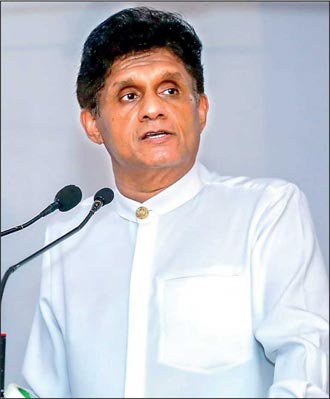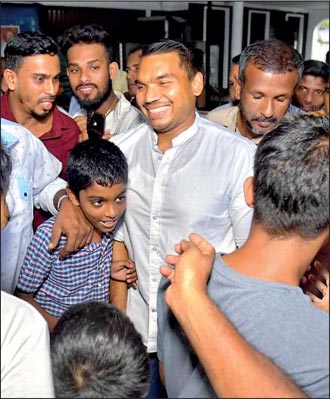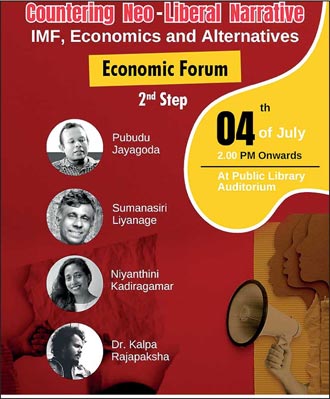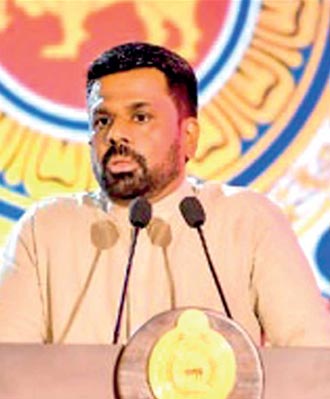Thursday Jul 10, 2025
Thursday Jul 10, 2025
Thursday, 10 July 2025 00:40 - - {{hitsCtrl.values.hits}}

No better leader for the SJB

Politician with the fastest-growing popularity

Sharpest critique of establishment economics

PrajaShakthi: No content, No program, No detail
‘…Mazagon’s entry into Colombo Port is not merely a commercial bailout — it is a strategic assertion in the Indian Ocean’s unfolding power play…’
(https://www.ft.lk/ft_view__editorial/India-s-Mazagon-s-acquisition-of-Colombo-Dockyard/58-778549)
 When Ranasinghe Premadasa ran for the presidency in October 1988, the country was ablaze with two civil wars. His manifesto, ‘A New Vision, A New Deal’ gave clear details about his proposed program for Poverty alleviation, Janasaviya. Throughout his election campaign in October-December 1988, Premadasa explained the concrete details of Janasaviya from every platform. Once elected, Premadasa commenced Janasaviya Round One, in the heartland of the JVP’s bloody uprising, Hambantota, in the throes of armed conflict.
When Ranasinghe Premadasa ran for the presidency in October 1988, the country was ablaze with two civil wars. His manifesto, ‘A New Vision, A New Deal’ gave clear details about his proposed program for Poverty alleviation, Janasaviya. Throughout his election campaign in October-December 1988, Premadasa explained the concrete details of Janasaviya from every platform. Once elected, Premadasa commenced Janasaviya Round One, in the heartland of the JVP’s bloody uprising, Hambantota, in the throes of armed conflict.
By contrast, it was only this month, July 2025, that President Anura Kumara Dissanayake announced a program to reduce rural poverty, Prajashakthi. It took him 9 months. I watched his speech on TV and read it in this newspaper and still cannot figure a single detail, a single concrete measure he hopes to take to reduce rural poverty.
His speech was only a sermon, not a rollout of a concrete plan and program, unlike Janasaviya --or even Sajith Premadasa’s ‘Husma’ and ‘Sakvala’. There are no criteria of identifying recipients, no pledge as to what or how much will be transferred, no geographic identifications, no timelines. We don’t know what it is, how it works, when and where. So far, there is no tangible content. It is typically vacuous rhetoric. (https://www.ft.lk/top-story/President-launches-Prajashakthi-national-program/26-778629)
Not UK Labour
The electoral base of the UK Labour government was saved by a rebellion by Labour parliamentarians against an important economic policy of budgetary number-crunching welfare cuts by Labour leader and Prime Minister Sir Keir Starmer. The policy, if implemented, would have meant a huge hit on disability payments and eroded the Labour Government’s popularity.
Luckily for the Labour Party it wasn’t the JVP-NPP. Its Parliamentary Group can’t be zombified and run by a Bimal Rathnayake. Therefore, Starmer was forced into negotiation with the Labour rebels and an intermediate compromise arrived at.
Dr. Jayalath Bandara Adikarige presents a brilliant two-part diagnosis of the ruling NPP. (https://www.ft.lk/opinion/Inside-the-Echo-Temple-Moral-binding-and-architecture-of-belief-Part-2A/14-778722)
No NM, no Vivi
Have you heard a single leader of the JVP-NPP (I don’t mean fellow-travelling columnist) publicly acknowledge that the first leftist Mayor of Colombo was LSSP leader Dr NM Perera in 1954-1956, and that the red flag was hoisted over the Colombo Town Hall by leftist firebrand Vivienne Goonewardene, an elected member of the CMC since 1950? I haven’t.
Speaking in Parliament, the NPP’s Dr. Kaushalya Ariyaratne accused the SJB with bemused scorn about its distress at the NPP candidate’s victory (the SJB was protesting the secret ballot) because “for the first time in history, the Colombo Mayoralty which was held by the bourgeois Right and was traditionally green, has been won by the Left and is now red”.
There was/is absolutely no recognition by the NPP-JVP of NM’s pioneering left victory and the action of Vivienne Goonewardena, the legendary woman militant who hoisted the red flag with the hammer-and-sickle (and digit 4 of the Trotskyist Fourth International) over the Colombo Town Hall, causing far more of a shock among the city’s bourgeoisie than the recent pinkish outcome. (Vivi: A Biography of Vivienne Goonewardena, Pulsara Liyanage, Women’s Education and Research Centre, Colombo, 1998.)
Foreign financial pirates
A landmark interview was given by outgoing Secretary to the Treasury and Ministry of Finance, Mahinda Siriwardena to Derana’s Kalindu Karunaratne. The key takeaway was Dr. Siriwardena’s emphatic, grateful, reiterated recounting of his experience of the seamless continuity of economic policy from Gotabaya Rajapaksa through Ranil Wickremesinghe to Anura Dissanayake.
Logically, if President Anura Dissanayake’s core economic strategy and policy program still permit the description of his administration as centre-left/progressive, then Ranil Wickremesinghe was also progressive (as was Gotabaya at the end of his term). The converse is true as well: if Ranil is rightist/neoliberal, so also is Anura. They endorsed and shared the same policy constellation.
Given AKD’s accurate 2024 pronouncement that it wasn’t MR (who repaid debt) and GR (who didn’t borrow), but Ranil’s 2019 borrowing surge from the private money markets which caused the foreign debt crisis, why continue seamlessly and without renegotiation, the self-same Ranil’s repayment deal with the IMF and foreign private creditors?
As a new President with a massive new parliamentary majority, a left provenance, and an Aragalaya backdrop, Anura Dissanayake could have used the arguments and expertise of Debt Justice group members such as Argentina’s former Finance Minister Prof Martin Guzman who secured a 50% ‘haircut’ for his country. AKD decided against even attempting to use ‘soft power’ to cut a better deal with the IMF and/or foreign private creditors.
Anura’s choice of Duminda Hulangamuwa, chairman of the Ceylon Chamber of Commerce as advisor/negotiator with the IMF and private creditors, and his frictionless adherence to the guidance of Nandalal Weerasinghe and Mahinda Siriwardena, revealed agenda and character. Anura pushed through Ranil’s ‘agreement-in-principle’ and was toasted in Canary Wharf.
Private foreign creditors, mostly giant asset management companies—financial octopuses-- are notorious for patronage of Governments and leaders in the Global South who let them walk away with undeservedly colossal profits garnered through ‘odious debt’.
In a dollar-strapped economy, what kind of rational—let alone progressive—President (and Finance Minister) would allow a dollar drain through relaxed import of luxury cars? (https://www.sundaytimes.lk/250706/news/vehicle-imports-treasury-alerts-cb-over-dollar-drain-603403.html)
FSP Educational Secretary Pubudu Jayagoda exposes AKD’s IMF agreement for its social perversity of exporting the dietary staples coconut and healthy local brown sugar, causing prices to rise, while importing unhealthy white sugar into our high-diabetes country. (https://youtu.be/lzvs5c4FWYw?si=c7TlfgBTYRdtuAjl)
Feeding Sri Lanka to India
Anura has given the Indian Defence Ministry, through an Indian warship-building company which it controls, a large footprint in the Port of Colombo. This at a time and situation when:
 India and Pakistan recently went to war.
India and Pakistan recently went to war.
 India is a pillar of the Quad together with the USA, Japan and Australia, explicitly aimed at ‘containing’, i.e., countering China.
India is a pillar of the Quad together with the USA, Japan and Australia, explicitly aimed at ‘containing’, i.e., countering China.
 India is a strategic partner of the USA which has named China as its main foe.
India is a strategic partner of the USA which has named China as its main foe.
The control by the Indian Defence Ministry’s Magazon of Colombo Dockyard, when taken together with the AKD administration’s undisclosed 7 (or 10) agreements with India, gives us the bigger picture. Anura has invited India to take over 66 oil tanks, build Trincomalee and its environs as a ‘hub’, link it up with Mannar, and link Mannar up with India in the matter of energy.
The Communist Party of Sri Lanka (CPSL) provides a lucid analysis.
‘…strongly condemns the reported acquisition of a 51% controlling stake in Colombo Dockyard PLC by India’s Mazagon Dock Shipbuilders Ltd—a company wholly owned by the Indian Ministry of Defence. This move represents not merely a commercial transaction, but a strategic encroachment on Sri Lanka’s sovereignty and maritime independence.
Mazagon Dock Shipbuilders, a key arm of India’s military-industrial complex, is responsible for building submarines and warships for the Indian Navy. Its chairman’s declaration that “this is not just an acquisition, it is a gateway” is a chilling admission of intent: to transform Colombo Dockyard into a forward operating base for India’s geopolitical ambitions in the Indian Ocean.
Colombo Dockyard is not just another shipbuilding facility. It is a vital node in the Indian Ocean’s maritime trade routes, with proven capabilities in ship repair, construction, and offshore engineering. Its strategic location and technical expertise make it a cornerstone of Sri Lanka’s maritime economy and national security, as well as a node for industrialisation.
It has experience of specialised technologies, especially the construction of fast attack craft. It ran at a considerable profit until the 2022 crisis, and it has the potential to do so again.
To allow a foreign military-linked entity to control this asset is to surrender a critical lever of our national autonomy. This is not investment—it is infiltration.
The price Mazagon Dock is paying for this acquisition, US$ 52.9 million, is a fraction of Sri Lanka’s annual budget and can be accommodated comfortably.
This acquisition must be viewed in the broader context of India’s expanding footprint in Sri Lanka:
 In July 2023, a joint statement between New Delhi and Colombo outlined plans for Indian involvement in port and logistics infrastructure in Colombo, Trincomalee, and Kankesanthurai.
In July 2023, a joint statement between New Delhi and Colombo outlined plans for Indian involvement in port and logistics infrastructure in Colombo, Trincomalee, and Kankesanthurai.
 The current National People’s Power (NPP) regime, which previously condemned so-called “Chinese colonialism” has continued the policies of its predecessor, including:
The current National People’s Power (NPP) regime, which previously condemned so-called “Chinese colonialism” has continued the policies of its predecessor, including:
 A secretive military agreement with India.
A secretive military agreement with India.
 The reported handover of Kankesanthurai Port to Indian control.
The reported handover of Kankesanthurai Port to Indian control.
 The controversial Trincomalee “energy hub” deal.
The controversial Trincomalee “energy hub” deal.
These developments point to a systematic erosion of Sri Lanka’s sovereignty under the guise of “mutual cooperation.”…’
--‘Hands off our sovereignty: Colombo Dockyard must remain Sri Lankan’, statement by CPSL General Secretary Dr. G. Weerasinghe, July 1st 2025
Anura Dissanayake is gifting strategic nodes (Colombo Port, KKS, Trincomalee, Mannar) and sectors (e.g., energy, shipbuilding) to neighbouring India.
 Many of these nodal points are located in our island’s North and East in which the majority populace is of the same ethnic, linguistic and religious group as those in the Southern Cone of India.
Many of these nodal points are located in our island’s North and East in which the majority populace is of the same ethnic, linguistic and religious group as those in the Southern Cone of India.
 Such strategic and economic integration would make the island’s Tamil majority North ‘functionally closer’ to India.
Such strategic and economic integration would make the island’s Tamil majority North ‘functionally closer’ to India.
 This would alter the domestic/internal geopolitical balance on this island against the strategic interests of its majority and the Southern two-thirds.
This would alter the domestic/internal geopolitical balance on this island against the strategic interests of its majority and the Southern two-thirds.
What the Sri Lankan state won back from the Tigers in a 30-years war, is being lost—ceded-- to India in a giveaway by President Dissanayake and the NPP. The penalty for the illegal donation of carrom boards being a quarter-century in jail, what is the penalty for the illegitimate feeding of a small island to its giant neighbour?
‘Common Opposition’
Though messily melodramatic, the election/selection process of the chairpersons of the Local Government bodies in which no single party scored 50%, has been positive.
AKD began with the forceful reiteration that his party, even when short of 50% while the non-NPP vote is 50% or more, will, as the largest single party, occupy the chairpersonship, preventing any Opposition combination from doing so. AKD’s ‘good governance’ lurch failed and the NPP had to go through the democratic process that the election rules prescribe.
By its preference for secret ballots, and its ‘good governance’ tactics in Weligama, the ruling NPP provided a glimpse of its true character, raising alarm as to its future conduct when the stakes are far higher in 2029.
The diverse Opposition grew accustomed to the practice of tactical convergence to the point that the term “Podu Vipakshaya” (‘the Opposition-in-common’) was spontaneously coined. Originating with the Multipurpose Cooperative society (MPCS) elections and strengthened at the LG elections, this spirit has yielded conversation and tactical cooperation between leaders of Opposition parties, prefiguring the possibility of a pluralist Opposition in 2029.
Sajith’s SJB leadership
There’s just one respect in which Sajith Premadasa reminds me of Winston Churchill, and that’s Churchill’s indelible defence of democracy as the worst system of government there is except for all the others. Similarly, Sajith is the worst leader the SJB could have except for all the others—especially those who see themselves as, or are touted as, possible replacements. Any other parliamentarian would entrench the party in the structural crisis the SJB faces, much more so than Sajith does.
The SJB’s crisis is ‘genetically’ or ‘generically’ inherited from its parent, the post-Premadasa UNP under Ranil Wickremesinghe’s leadership. Under Ranil-- not JR, still less Premadasa-- the UNP adopted (1997) neoliberalism and unpatriotic cosmopolitanism, causing and commencing the long downswing from the country’s largest single party to the pathetic residue of today. Ranil’s UNP never produced a popularly elected leader of the country, an elected President. It elected a Prime Minister 15 years apart, and never re-elected him for a consecutive term.
Its electorally toxic economic and anti-state/anti-national ideology was carried over from the UNP to the SJB, which should have been founded instead on Ranasinghe Premadasa’s economic philosophy which had saved the UNP from extinction in 1988. Thus, the SJB lost the 2024 Presidential and parliamentary elections it was poised to win in 2019-2022. It was shockingly surpassed in 2023-2024 by Anura’s JVP with its 3% and 3 seats.
The SJB whose personalities and actions contributed more to sparking the Aragalaya in 2022 than did the JVP, slit its wrists electorally when its most prominently advertised ideologues explicitly advocated “bitter economic medicine” and applauded the policies of President Ranil Wickremesinghe.
The personalities whose names are suggested as replacements for Sajith are precisely those who identified with Ranil’s policies, and wrecked the SJB’s status as an alternative, indeed as the Opposition. The electorate predictably responded to Ranil’s “bitter economic medicine” by bestowing him with a third defeat at a Presidential election in as many attempts.
It wasn’t Sajith but Harsha de Silva who endorsed and identified with Ranil’s policies of constriction and austerity, but it was Sajith who had placed Harsha-Eran and their ‘Blueprint’ on a pedestal.
Under Harsha’s leadership the SJB would drop to the 15%-20% range, ignored by the rural voters and urban underclass-- more so if the effort to linkup the SJB and UNP on a ‘Unite the Right’ platform succeeds. An SJB-UNP bloc under Sajith’s leadership and a progressive-centrist program could enhance votes, but under a Harsha-Ranil leadership and a liberal economic platform it would wind up a permanent ‘third party’ like the UK Liberal Democrats.
No self-declared Right has ever won a Sri Lankan election. Moreover, the right-wing economic policies of the Anura administration cannot be defeated by a right-wing challenger—there’s hardly any space to the right of AKD-NPP. Sajith shouldn’t be replaced, but reinforced by Dayasiri Jayasekara as Deputy.
Partnership for dynamic development
1. AKD-NPP’s economic and external policies (including enhanced Israeli encroachment) being demonstrably rightist, arguably the most rightist policy agenda since 1948, the country must rebalance by (re)constructing a moderate, progressive-democratic centre.
2.Only through a reconstructed progressive Centre can we transition to a Centre-Left, and subsequently a mature, capable Left-Centre government (of the Brazil-Mexico type).
3. A patriotic-progressive centre is also the only buffer against a backlash by the toxic Sinhala-Buddhist ultranationalist lobby (which ruined Gotabaya).
4.The three national priorities are:
a)Rapidly reviving the economy while simultaneously reducing poverty.
b)Restoring national independence, sovereignty, territorial unity, integrity and strategic autonomy.
c)Renewing Sri Lanka’s multi-polar, multi-vector global support and balanced stance.
5. No single political leader/party is equipped to do all three. A division of labour is necessary.
6. It is difficult to imagine any single political leader or party able to win both Presidential and Parliamentary elections in 2029.
7. Ranasinghe Premadasa gave us growth-with-equity and the 200 garment factories export-led industrialization drive. Mahinda Rajapaksa (with China’s support) built infrastructure and the Port City with its potential. (https://www.ft.lk/business/A-city-rising-How-Port-City-Colombo-secures-Sri-Lanka-s-tomorrow/34-778567).
8. Sri Lanka must replace the unproductive, developmentally dysfunctional NPP with the synergy of the Ranasinghe Premadasa-Mahinda Rajapaksa development models.
9. Sajith and Namal must represent the two models; lead the two centrist currents and converge into a dynamic developmental engine.
10. If the Opposition’s Centre-Right and Centre-Left run against each other instead, then populist voter volatility will make the pick.
Discover Kapruka, the leading online shopping platform in Sri Lanka, where you can conveniently send Gifts and Flowers to your loved ones for any event including Valentine ’s Day. Explore a wide range of popular Shopping Categories on Kapruka, including Toys, Groceries, Electronics, Birthday Cakes, Fruits, Chocolates, Flower Bouquets, Clothing, Watches, Lingerie, Gift Sets and Jewellery. Also if you’re interested in selling with Kapruka, Partner Central by Kapruka is the best solution to start with. Moreover, through Kapruka Global Shop, you can also enjoy the convenience of purchasing products from renowned platforms like Amazon and eBay and have them delivered to Sri Lanka.
Discover Kapruka, the leading online shopping platform in Sri Lanka, where you can conveniently send Gifts and Flowers to your loved ones for any event including Valentine ’s Day. Explore a wide range of popular Shopping Categories on Kapruka, including Toys, Groceries, Electronics, Birthday Cakes, Fruits, Chocolates, Flower Bouquets, Clothing, Watches, Lingerie, Gift Sets and Jewellery. Also if you’re interested in selling with Kapruka, Partner Central by Kapruka is the best solution to start with. Moreover, through Kapruka Global Shop, you can also enjoy the convenience of purchasing products from renowned platforms like Amazon and eBay and have them delivered to Sri Lanka.